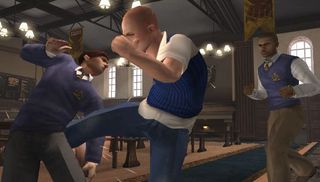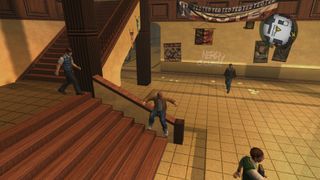Bully showed a Rockstar game could have heart as well as action
Reinstall.

Reinstall invites you to join us in revisiting classics of PC gaming days gone by. Today, Sam Roberts brushes up on his high school etiquette for a return to Bully's halls of mischief.
Bully starts with the shitty experience of going to a new school and ends with a subculture civil war. Certain media outlets flew off the handle when Rockstar announced they were making a game titled Bully, given their traditional adult subject matter and the context of the story, but the irony is that this is Rockstar's softest and silliest game, with the warmest heart.
The GTA open-world template is borrowed almost in its entirety; even missions and distractions are similarly represented on the map. Instead of matching the earlier San Andreas's scale, however, Rockstar Vancouver pursued detail and intimacy: the town of Bullworth feels about the size of an island in GTA 3.
What you get instead is an environment that shares more DNA with a Deus Ex hub or Arkham City, where there's logic behind the placing of buildings and a more handcrafted feel to the art direction. It's a more experimental approach to open-world design from Rockstar. I see Bully as their passion project, the chance to take commercially proven game mechanics and apply to them to the sort of story no other developers would think of telling.
Your character, troubled teen Jimmy Hopkins, can't parachute out of a fighter jet or use a jetpack. The most extreme means of transport is a scooter, and even then the worst punishment for running someone down with it is either mowing the lawn in detention or being sent back to school.
There's a lot of motor-mouth dialogue in the cutscenes: the school subcultures are treated as GTA-style gangs, Jimmy's reputation in each fluctuating as circumstances change. All adhere to American stereotypes of nerds, jocks, greasers, prep kids and so on, with a fragile class structure that revels in its silliness.
Bully feels part-biographical and part-fantastical to me. Only Jimmy and the story's far more interesting villain, the manipulative sociopath Gary, come across as characters who could be based on real people. In a scene that's all too likely, Jimmy is abandoned at the gates of the school by his mother, who is distracted by the new boyfriend in her life.
PC Gamer Newsletter
Sign up to get the best content of the week, and great gaming deals, as picked by the editors.
The more fanciful side of Bully has Hopkins manning a mounted potato cannon, throwing bags of marbles at coppers or swimming out to a sunken pirate ship in the bay. It's a Goonies-like slice of '80s movie wonder that adds a touch of magic to an otherwise realistic-feeling locale. That slight extension beyond reality gives Bully a distinctive identity.

A more obvious treat comes in the way the town adapts to the seasons of the school year, introducing relevant NPC and environmental revisions with themed missions to match. You'll see Bullworth strewn with pumpkins for one night only, or transformed into a snowy wonderland at Christmas, which creates a more personal connection to its world than anything in GTA's sprawling cities.
Bullworth Academy is 25% what school was like, then 75% more fun stuff that I never got to do at GCSE. I don't remember English class being a three-minute game of spotting anagrams on a board, for example, though it's a lot more entertaining than pretending to do Michael Caine's accent while reading Educating Rita. Rockstar use lessons as a progression system for unlocking new weapons and skills for Jimmy, and some are smartly specific to their subject, such as labelling countries on a map in Geography. Others are tired QTE affairs and a bit of a drag.
I like that Rockstar try to make being a school kid fun, and they mostly succeed. Bully offers many reminders that you're playing an adolescent, rather than a cold-hearted GTA killer. One aside that differentiates Bully from GTA more than anything else is that Jimmy falls asleep if he doesn't go to bed by a certain time and will wake up in his underpants if he's been robbed. This is more Bash Street Kids than Goodfellas. Rockstar don't need adult content to create a compelling narrative arc, it turns out, yet so far Bully remains the only game where they've done without.

The outdated parts of Bully are mostly shared with GTA, from which it inherits camera-spinning shooting and sometimes imprecise melee combat. The latter in particular seems overly simplistic given how much time Jimmy spends punching people in the face. Yet Bully is easily the most refined of its era of Rockstar titles, aided by a consistent difficulty curve. The physics and cutscenes are the obvious indicators of its age: the characters look like crash test dummies with spades for hands.
Even if they look like Captain Scarlet when they talk, I did at least remember many of Bullworth's students prior to reinstalling. Many of the NPCs walking around Bullworth have specific names and faces, forming the large ensemble cast of the story. It's a small touch, but photographing each student creates entries in your yearbook, telling you who they are and which faction they belong to, a hearty attempt to make them feel like a real group of people.
The Scholarship Edition released on PC in late 2008—the last Rockstar game to be built on RenderWare before GTA 4 arrived on PC just over a month later—is a flawed port. While some of the framerate issues were resolved with a patch, some blatant problems with texture popup and lighting are unlikely to ever be fixed. Still, I think it's especially worth playing if you're only familiar with Rockstar's more recent output.
The approach Rockstar Vancouver took to designing Bully has left it feeling bizarrely contemporary. The evolution of open world design has increasingly been about character rather than just scale. As I unload potatoes at prefects before escaping on a skateboard, I reckon Rockstar worked that out years ago.
Most Popular


